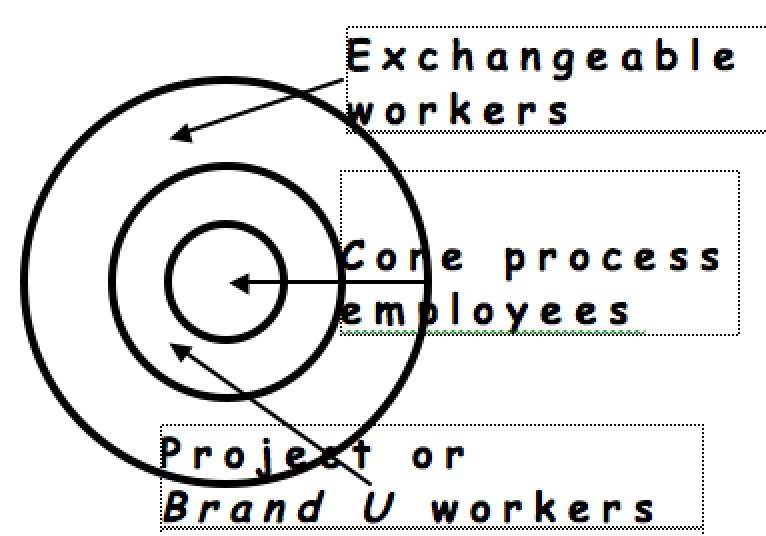 Innovation and technology drive this model. Moore’s Law basically says computer chip processing power doubles every 18 to 24 months. We’re seeing this in almost every industry. For example, high-powered computers allow automakers to design two vehicles in the time they spent on designing one and do it in half the time.[i]
Innovation and technology drive this model. Moore’s Law basically says computer chip processing power doubles every 18 to 24 months. We’re seeing this in almost every industry. For example, high-powered computers allow automakers to design two vehicles in the time they spent on designing one and do it in half the time.[i]
Handy believed a company would resemble three concentric rings:
- Inner ring. The job of the corporate center is to be in charge of the future – keeping an eye on the competition, on new markets, and on strategy. The center is also in charge of the organization’s overall architecture and design of the center’s responsibilities.[ii] The inner ring, the organizational core, is composed of corporate insiders, managers, and professionals. They are the glue that holds the organization together and grows it. These insiders may be highly trained entrepreneurs, executives, professionals, marketing strategists, engineers, and accountants who maintain the core organizational processes and sustain the institutional memory. These full-time employees define the organization’s vision, mission, principles, culture, and ethics. This inner ring also determines the organization’s core process competencies that distinguish it from the competition.
- Middle ring. Brand U portfolio or project workers inhabit the middle ring according to this model. These people are Brand U contractors or temporary workers. I call these project people because they’re mainly involved in discrete projects with a definite beginning and end. These people offer marketable, transferable skills, knowledge, and abilities that add organizational value. These skills are portable and can be sold to the highest bidder. A Brand U may become an itinerant professional selling his or her skills from employer to employer.
- Outer ring. The outer ring is composed of largely interchangeable and disposable workers. These workers are often less skilled service employees. Many are marginal workers who service the repetitive needs of the organization such as food service, administrative chores, or travel services. [iii]
[i]White, Gregory and Warner, Fara, “Bumper Crop: Competition Rises, Car Prices Drop: A New Golden Age?” Wall Street Journal, January 9, 1998, p. A1.
[ii]Handy, Charles, “Corporate Center,” Executive Excellence, December, 1998.
[iii] Handy, Charles, Beyond Certainty: The Changing Worlds of Organizations, Harvard Business School Press, 1996, pp. 23-33.